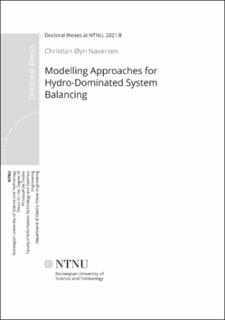| dc.contributor.advisor | Farahmand, Hossein | |
| dc.contributor.author | Naversen, Christian Øyn | |
| dc.date.accessioned | 2021-03-29T06:49:16Z | |
| dc.date.available | 2021-03-29T06:49:16Z | |
| dc.date.issued | 2021 | |
| dc.identifier.isbn | 978-82-471-9760-8 | |
| dc.identifier.issn | 2703-8084 | |
| dc.identifier.uri | https://hdl.handle.net/11250/2735828 | |
| dc.description.abstract | The generation mix in many power systems across the world is rapidly shifting towards higher degrees of variable renewable power generation. Maintaining the continuous power balance of the system under higher levels of uncertainty and variability requires better planning and use of the available flexible resources. Norwegian hydropower is one such flexible resource, and the ongoing construction of substantial transmission capacity to neighboring areas with high penetration of wind and solar generation can enable the use of the hydropower as a balancing resource for the North European region. Understanding the interaction between hydropower, thermal generation, and variable renewable power sources under conditions of uncertainty is paramount in order to effectively and securely plan the operation of the system.
The work conducted in this thesis has investigated the modeling of the shortterm production and reserve scheduling of systems with considerable amounts of hydropower. A fundamental approach to modeling the different power imbalances that create the need for reserve capacity and subsequent balancing energy has been adopted in all of the models. Representing large-scale cascaded hydropower in the models has been essential and has motivated the development and adaptation of several different optimization methodologies. The work has been disseminated in four scientific papers, three published and one submitted for review at the time of writing, which constitute the backbone of the thesis. The thesis includes a thorough discussion and literature review on the core topics considered in those papers. A summary of the different models created and the main results of the work performed during this PhD is provided below:
• Two-stage models based on stochastic, robust, and hybrid uncertainty formulations were developed to investigate the impact of reserved capacity on hydropower plants being activated due to forecast errors in the net-load. The hybrid stochastic-robust model was found to be a good compromise between cost optimality and protection from extreme events. The distribution of reserves among the different hydropower plants is noticeably different in a deterministic model that does not consider the delivery of balancing energy, which impacts the cost of balancing the system. This effect is due to the strong temporal and topological coupling between hydropower plants created by the cascaded hydropower topology.
• A hydrothermal model formulation using the continuous-time optimization framework was developed, where several modifications to the previously published continuous-time unit commitment problem were made to accommodate the inclusion of hydropower. The structural imbalances created by the discrete spot market clearing are not present in the continuous-time formulation since the power balance is kept at all times. The continuous-time model can potentially be used to estimate the cost of removing structural imbalances when compared to a standard discrete-time model. The possibility of adding continuous ramping constraints for thermal units shows how Norwegian hydropower can be used to alleviate ramping scarcity in neighboring areas.
• Combining stochastic optimization and the continuous-time formulation creates a model that can capture imbalances created by both the market structure and forecast errors. The results from a stylized case study of Northern Europe with uncertain offshore wind power show that Norwegian hydropower is a principal provider of reserve capacity and balancing energy in the system. The cost increase compared to an analogous discrete-time model is roughly 0.4% of the total daily expected system cost, which stems from balancing sub-hourly wind and load variations and employing more accurate thermal ramping constraints and startup/shutdown procedures.
In addition to the research published in the papers, the thesis includes Appendix C, which is a valuable resource for anyone interested in understanding and implementing the continuous-time formulation. The material in the appendix is based on the published literature on the topic and personal experience, and was written because no other comprehensive introduction to continuous-time unit commitment exists at the time of writing. | en_US |
| dc.language.iso | eng | en_US |
| dc.publisher | NTNU | en_US |
| dc.relation.ispartofseries | Doctoral theses at NTNU;2021:8 | |
| dc.relation.haspart | Paper 1: Naversen, Christian Øyn; Farahmand, Hossein; Helseth, Arild. Accounting for reserve capacity activation when scheduling a hydropower dominated system. International Journal of Electrical Power & Energy Systems 2020 ;Volum 119.
https://doi.org/10.1016/j.ijepes.2020.105864
This is an open access article under the CC BY license
(http://creativecommons.org/licenses/BY/4.0/). | en_US |
| dc.relation.haspart | Paper 2: Naversen, Christian Øyn; Helseth, Arild; Li, Bosong; Parvania, Masood; Farahmand, Hossein; Catalao, João P.S.. Hydrothermal scheduling in the continuous-time framework. Electric power systems research 2020 ;Volum 189.
https://doi.org/10.1016/j.epsr.2020.106787
This is an open access article under the CC BY license
(http://creativecommons.org/licenses/BY/4.0/). | en_US |
| dc.relation.haspart | Paper 3:
Øvstebø, Mari Lund; Naversen, Christian Øyn; Helseth, Arild; Farahmand, Hossein.
Continuous-time scheduling of a hydrothermal system with integration of offshore wind power. I: 2020 17th International Conference on the European Energy Market - EEM. IEEE 2020 ISBN 978-1-7281-6919-4.
https://doi.org/10.1109/EEM49802.2020.9221980 | en_US |
| dc.relation.haspart | Paper 4:
Naversen, Christian Øyn; Li, Bosong; Parvania, Masood; Helseth, Arild; Farahmand, Hossein.
Stochastic Flexibility Coordination in Hybrid Hydro-Thermal- Wind Power Systems.
© 2021 IEEE. Personal use of this material is permitted. Permission from IEEE must be obtained for all other uses, in any current or future media, including reprinting/republishing this material for advertising or promotional purposes, creating new collective works, for resale or redistribution to servers or lists, or reuse of any copyrighted component of this work in other works. | en_US |
| dc.title | Modelling Approaches for Hydro-Dominated System Balancing | en_US |
| dc.type | Doctoral thesis | en_US |
| dc.subject.nsi | VDP::Technology: 500::Electrotechnical disciplines: 540::Electrical power engineering: 542 | en_US |
